Disclaimer: neither the author nor www.newlifeonahomestead.com are responsible for the side effects resulted from applying the advice given in this article. The advice in this article is for information purposes only.
Mushroom foraging is one of my favorite hobbies. In addition to providing me with delicious treats, the experience of searching for mushrooms deepens my relationship with the forest. It encourages me to look for details in the ecosystem around me rather than just passing through. I have made many memorable meals from wild mushrooms. Their taste is like nothing else in the world.
If you are interested in getting into mushroom foraging, but are (justifiably) afraid of poisoning yourself, this article is for you. It contains lots of advice to help people get started with these gourmet treats! Once you start, you are likely to be hooked!
But Isn’t Mushroom Foraging Dangerous?
People have certainly died from eating wild mushrooms. However, a few rules will help you avoid this outcome. These rules are quite simple, and do not take a lot of expertise to understand.
Avoiding Fatal Mushroom Poisoning
Rule #1-
“If you can’t identify it, don’t eat it.”
It’s that simple. If you are not 100% sure what a mushroom is, just give it a pass. This extends to gifts as well. People have been poisoned by mushrooms that were given to them.
Rule #2-
“The only way to tell whether a mushroom is edible or poisonous is by identifying the mushroom.”
A mushroom’s general appearance gives you no information at all about whether it is poisonous. There are gnarly, dark black mushrooms that are delicious. There are plump, ordinary looking mushrooms that are poisonous.
Interestingly, people who have survived eating highly poisonous “death caps” have reported that the mushrooms tasted extremely good. This should serve as a warning that a mushroom’s taste is no indication of whether it is poisonous. Many of these “survivors” actually needed liver transplants in order to continue living, so the experience was certainly not worth it.
There is a little bit of folklore out there about mushrooms. For example, there is a saying that poisonous mushrooms will blacken silver. There is no general rule that all poisonous mushrooms are bound by. Which brings us to the next rule…
Rule #3-
“Learn the most poisonous mushrooms.”
Most fatal mushroom poisonings are caused by a single species: Amanita phalloides, also known as the “death cap.” The remainder are spread out over just a few varieties. These include another Amanita, Amanita bisporigera, the “destroying angel,” and If you take the time to learn what these species look like, you can avoid a fatal mistake.
Highly poisonous Amanitas a different appearance when they first emerge from the soil than they do as fully grown mushrooms. As fully grown mushrooms, they look like stereotypical “toadstools.” However when they first poke up through the soil, they look like round eggs. It is important to note both of these phases to avoid confusing them with other mushrooms.
Recognizing highly poisonous mushrooms is also important for protecting your pets and children. You must keep children small enough to indiscriminately put things in their mouths away from these. There are also hundreds of recorded pet poisonings from mushrooms, with dogs being the most common victims.
Rule #4-
“Don’t eat Amanitas.”
The “death cap” mentioned above is a member of the Amanita genus. This genus includes other poisonous mushrooms, and a few that are not poisonous. People have died because they mistook the poisonous death cap for a benign Amanita.
I have looked at websites and videos with detailed instructions for distinguishing edible and poisonous Amanitas. All I can say is, “Why?” I just don’t understand why anyone would forage for something that closely resembles a deadly poison. Even chefs and mushroom “experts” have made fatal mistakes.
I’m sure people get some satisfaction from correctly identifying edible Amanitas. Edible Amanitas are also supposedly among the most delicious of all wild mushrooms. Personally, I’m content to go the rest of my life without finding out.
If you stick to these rules, you will substantially reduce your risk of being killed by a mushroom. The next list of rules deals with mushrooms that won’t kill you, but might make you wish you were dead.
Avoiding Other Forms of Mushroom Poisoning
There are only a handful of mushrooms that can kill you. There are may more that cause “gastrointestinal distress:” stomach cramps, vomiting and diarrhea. Most people will survive these symptoms. However they could be extremely dangerous for people who already have a chronic illness, people in remote settings, and others with a smaller safety window around their health.
There are a few rules for avoiding this experience as well.
Rule #5-
“Only try a small serving of each mushroom you have never had before.”
There are some mushrooms that are not poisonous to the general population. However, they cause idiosyncratic reactions in a few people. This reaction is generally “gastrointestinal distress.” Members of the bolete family such as birch boletes are often like this. The safest way to make sure a mushroom will not make you sick is to try a tiny bit of it, and then wait at least 24 hours before having another serving.
Rule #6-
“Be careful with alcohol.”
There are several mushrooms that will not make you sick on their own, but that do have bad reactions with alcohol. Be sure to research whether any particular mushroom should not be combined with alcohol.
Rule #7-
“Practice strict segregation in your mushroom basket.”
You may be out collecting edible mushrooms when you come across a variety you are not certain about. Being a good forager, you can be sure it is not one of the most poisonous varieties out there because you already know about those. You think it might be an edible variety but you can not be sure until you examine it further at home. This mushroom should not just go in a bag with all the mushrooms you plan to eat. It must be kept separate until you have more information.
Rule #8-
Once again, “If you can’t identify it, don’t eat it!”
How to Start Foraging for Mushrooms Step by Step
Now that we’ve gotten some of the warnings out of the way, it’s time to start learning about mushrooms.
Purchase a Field Guide
Don’t take your book out into the field and start eating mushrooms right away! You need a little bit of time and experience before you put your life at stake. A classic book that is good for most of North America is “All that the Rain Promises and More” by David Arora. There may be additional field guides that are appropriate for your area.
Take your new field guide home and flip through it. Start learning about poisonous varieties right away. Start learning the vocabulary in the book. Look at the pictures. Look at the ranges and see which mushrooms are likely to be found in your neck of the woods. What jumps out at you as particularly interesting? This can help you to figure out what you want to spend time learning more about in the future.
This step is important because your next step should be to take a class or attend an event, if possible. These events typically convey an enormous amount of information. It will be easier for you to retain this information if you have at least leafed through a field guide beforehand.
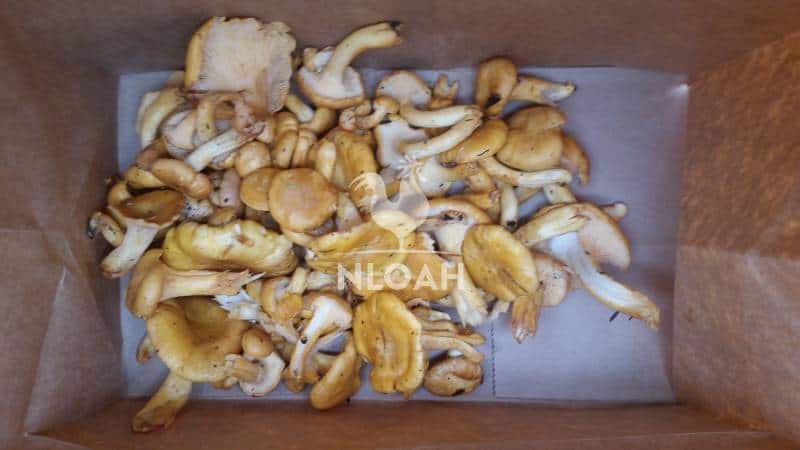
photo above: A bag of delicious golden chanterelles
Learn from Real People, Looking at Real Mushrooms
Videos and books can only get you so far. You must find a way to spend time with people who have expertise out in the field. But how to find these people? Fortunately, there are many mushroom hunters who love to share their passion.
Here are a list of places to seek out instruction about mushroom hunting:
- Community College
- Many community colleges offer a 1-credit class for a few days when mushrooms are in season. You can learn quite a bit from these, and the instructors’ qualifications are usually great. The only drawback is that they can be expensive. If you qualify for any kind of tuition waiver or if you can afford a class, this is a no-brainer. Alaska seniors qualify for free tuition at all of our local colleges. Is this true for many other states?
- Mushroom Festivals/Conferences
- These are super fun events where you can learn a huge amount about mushrooms. Demonstrations of mushroom dyes, lectures about advances in medicinal research, and of course information about foraging, are just some of the topics that could be covered. What’s more, there are usually a lot of interesting and friendly people at these festivals.
- Your local Mycological Society
- Mycological society is a fancy name for mushroom club. These groups are most often run by volunteers who are passionate about fungus! They hold many lectures, walks, and other events. Doing some homework in your field guide before attending these may serve you well. The events can be fast paced, and throw a lot of mushroom jargon around. This is a great way to meet people in your area interested in mushroom foraging.
- Freeskool
- Freeskools are schools where people teach each other skills, for free. They are typically run by anarchists or other radicals with the aim of promoting self-sufficiency and decentralizing access to information.
Start Honing Your Skills
Take your field guide and your new knowledge out into the field and start identifying mushrooms! Many foragers use a basket to keep their mushrooms from getting crushed while foraging. Keep a supply of wax or paper bags in the basket for different mushrooms. Never use plastic, as this causes mushrooms to rot.
You will quickly realize you don’t want to miss out on mushroom opportunities on any outdoor excursion. Tuck a hasty kit into your pack whenever you go outdoors. This should consist of at least a field guide and a reusable shopping bag with wax paper bags within it.
As you find new mushrooms, look at them closely. See if you can identify them to the group level in your field guide. Is it a bolete? A chanterelle? A morel? A false morel? Do you want to take any mushrooms home to make spore prints from them?
You may go for several walks without finding any mushrooms to eat. At this stage, you are just training yourself to recognize different mushroom characteristics and categories. Be patient.
Developing a Search Image
Predators develop a “search image” that helps them to spot their prey amid all the visual symbols in their habitat. The more they encounter this particular prey, the more this prey seems to “stand out” from its surroundings. The same thing happens with people and mushrooms. At first, the forest floor looks like just a mass of leaves and sticks. Over time, and with experience, more and more mushrooms “jump out” at you.
Ready to Start Eating the Mushrooms You Harvest?
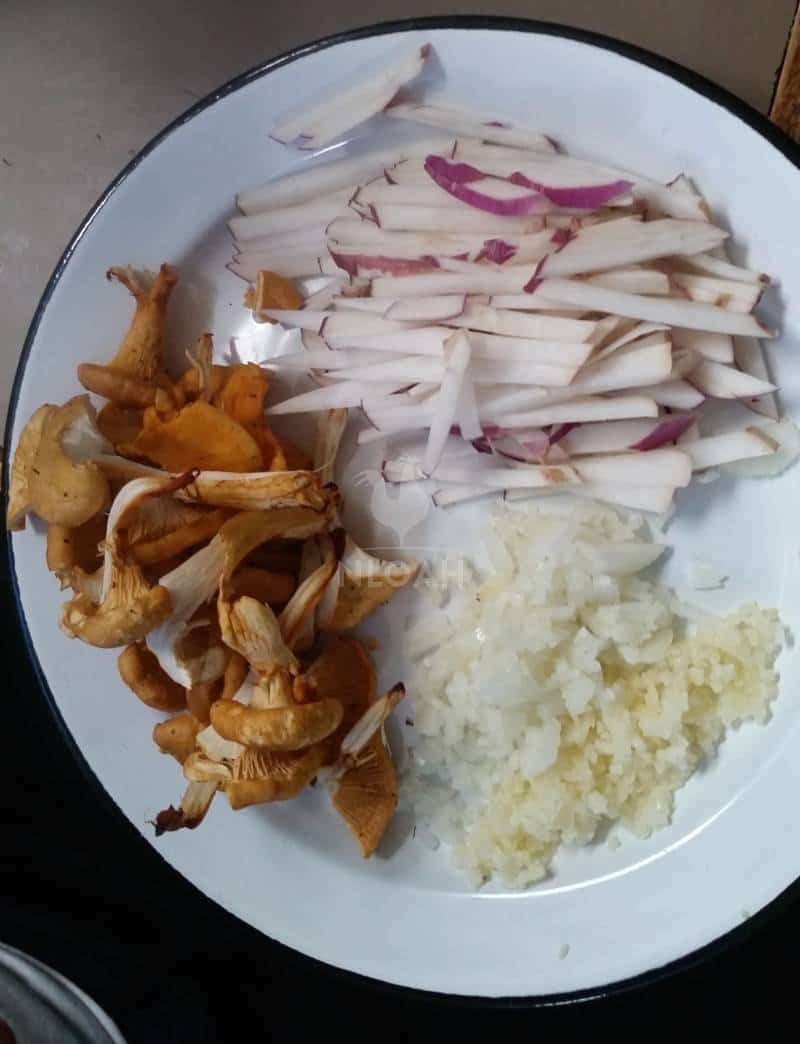
Above photo: Mise en place with golden chanterelles, home grown radishes, and garlic.
When you feel really, really confident with your skills, it’s finally time to start eating mushrooms. But how to test yourself?
One way to test yourself is to go on a walk with a more knowledgeable person and identify edible mushrooms correctly 100% of the time. An A-minus is not good enough when a mistake can be fatal!
Start With Mushrooms that Do Not Have Poisonous Lookalikes
Many field guides will single out mushrooms that do not have poisonous lookalikes. Hedgehog mushrooms are an excellent example. There are several species, and some taste better than others. However, none of them are poisonous.
Learn About Edible Mushroom Seasons and Habitats
Learning when different mushrooms are in season can help you narrow your search. You also want to research mushrooms’ habitat to help you narrow down where to go.
To give a real life example, morels are typically in season in early spring. They grow in disturbed or burnt areas and on gravel bars, where little else grows. Therefore, you probably won’t go mushroom hunting on a gravel bar in the late summer. In spring, however, well houses, train tracks, former forest fires, and many other disturbed areas are excellent places to hunt.
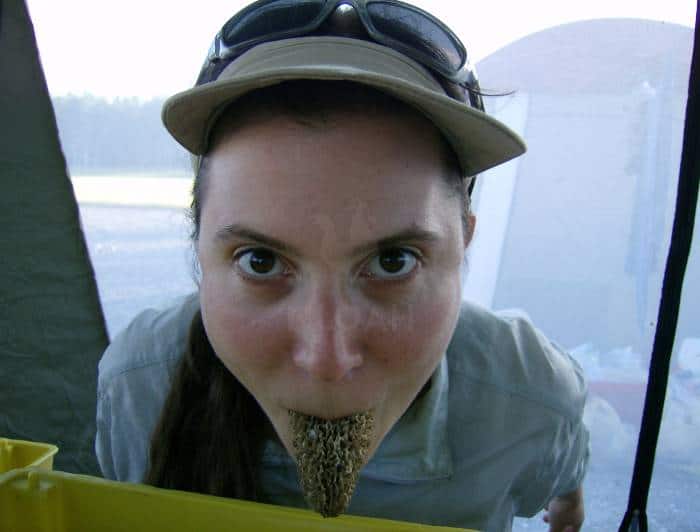
Above photo: Fun with Morels- A Morel “Tongue”!
The Best Times to Forage Depend on the Weather
Mushrooms are just the reproductive structures of a larger organism beneath the soil. In this way, they are similar to apples on a tree. When the weather conditions are right, this organism produces “fruiting bodies,” in our case, mushrooms. Most mushrooms require a wet environment for reproduction to occur. For this reason, rain is a big stimulus for mushroom production.
The best time to forage for mushrooms is usually a day or two after rain. You will learn to hone your timing as you forage more. If it rains and rains and rains, you may find the mushrooms are soggy and unappetizing. If you go out too soon, the mushrooms may not have developed yet. If you go out too late, maggots and other creatures may have found the mushrooms before you do.
The best way to really become an expert is to keep a journal of the daily weather, and your foraging results. I must admit I haven’t been this ambitious in my own life. However, I have developed a pretty good sense of the weather patterns that will produce the mushrooms I am looking for. In my experience, an alternation of rain with warm, sunny days produces the best mushroom crops.
I have sometimes arrived at an area to find that all of the mushrooms are old and full of worms. In these cases, I know it is time to wait for another rain to renew the harvest.
Find One, Find More
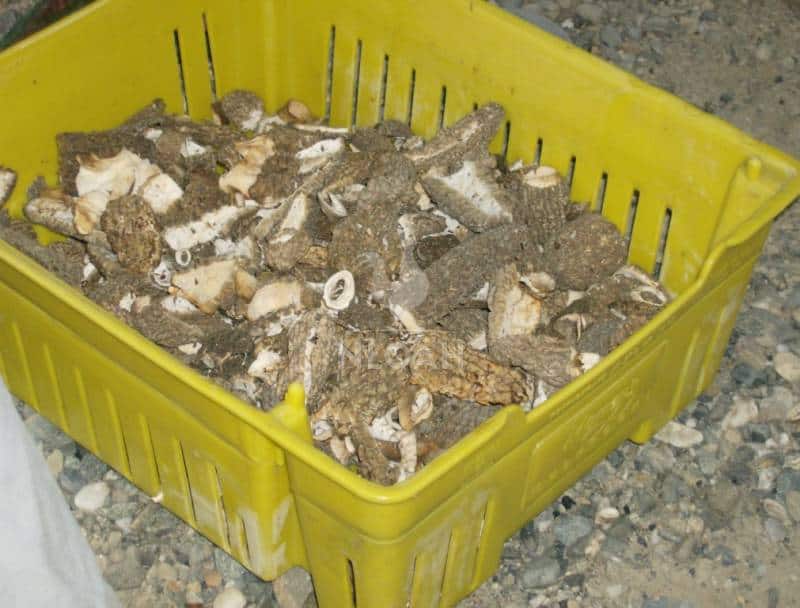
Photo above: A Basket of Morels
As stated earlier, mushrooms poke up from a larger, underground organism. If you find one mushroom, there is a good chance there are others nearby. Once you see the first one, either leave it be or mark the spot. Then, slowly and carefully examine the area radiating out from that mushroom.
When you see an edible mushroom, search the area around it thoroughly. It is likely that there are more nearby. Take notes about everything. Are you on a slope or on flat ground? Are you facing south, north, west, or east? Which trees are around? Which other mushrooms are around? How long has it been since it rained? What is your elevation?
Once you have identified the kinds of places where your mushrooms of choice live, you should be able to notice this habitat in your future travels. My friends think I’m a wizard when I peer of the trail and say, “Oh, I wonder if there are mushrooms there.” I wish I was a wizard, but the reality is that the spot I am looking at resembles others where I have found mushrooms in the past.
Return to the Same Spots
Some mushrooms will bloom every time it rains. Some will not. You can keep paper notes, GPS points, or whatever it takes to re-locate your mushrooms. Over time, hopefully, you can keep yourself busy just recirculating between your different spots.
Mushroom Harvest Ethics
Cut vs. Pick
Mushroom experts with far more knowledge than I have argue over whether it is best to cut mushrooms off at the base with a knife or harvest the whole mushroom whole. The argument for plucking the above and below ground portion of the mushroom out of the ground is that an above ground stem gives pests an opportunity to invade. The argument for cutting the mushroom off is that it does not disturb the organism beneath.
A lot of research has been done on this topic and the verdict seems to be: It doesn’t matter.
Personally, I prefer to cut mushrooms off. This brings less dirt and debris into my harvest. Excessive cleaning can damage the mushrooms, so having less dirt on them to begin with is helpful. Dirt from one stem can scrape and scratch up another cap, too, making it less choice.
Should You Leave Some Mushrooms Behind?
This is another hotly contested topic. Again, it does not seem to matter. Researchers have harvested some mushroom patches clean, and intentionally left mushrooms behind in others. The end result is that the mushrooms’ long term producing power was unchanged.
The above results are true only for mushrooms, which are sort of similar to the apples produced by a tree. Pick the apples, and the tree is still there. Other wild products are vulnerable to overharvesting. Do not extend this example too widely.
Be a Good Citizen
Mushroom foraging at the commercial level has damaged some areas. Unscrupulous foragers seeking only profit have brought crews of people into delicate areas who do not even practice the most basic forest etiquette regarding litter or human waste. Crews have removed underlying vegetation, or even used leaf-blowers, to make mushrooms easier to find. Crews have trampled endangered species and eroded streams. This is, of course, bad for the environment.
Most foragers, whether personal or commercial, would never dream of such outrageous behavior.
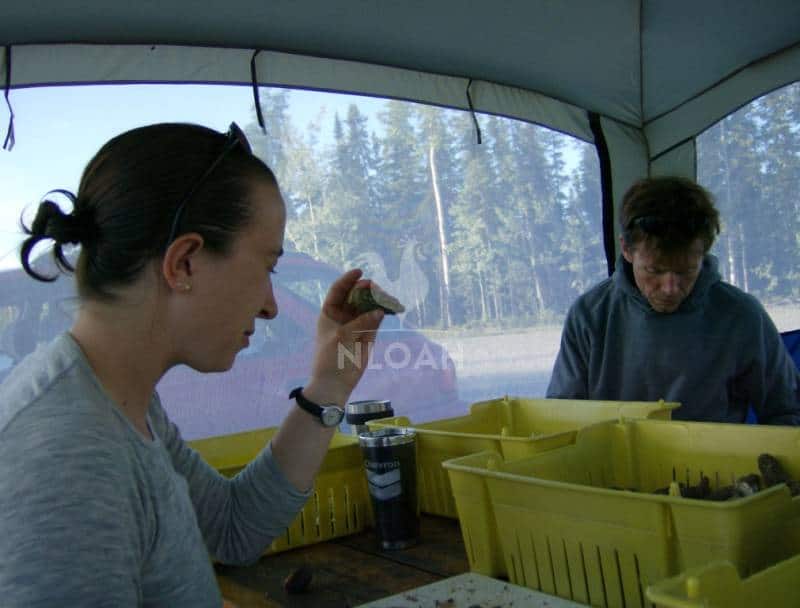 Photo: Commercial foragers examine morels for quality. This particular group is extremely conscientious about their impact on the local community and the environment.
Photo: Commercial foragers examine morels for quality. This particular group is extremely conscientious about their impact on the local community and the environment.
Maintaining etiquette is important because bad behavior jeopardizes foraging for all. Local people will kick all the mushroom hunters out, or lobby for strict regulations, if they think all foragers behave badly. For example, mushroom hunting of any kind is illegal on many of California’s public lands.
In some areas, personal use foraging is legal while harvesting for sale is illegal. This is meant to discourage the worst foragers from coming to the area. This is somewhat unfair to the many foragers who do behave ethically. However, it also protects the environment from being degraded by unscrupulous mushroom hunters.
Private property is another big issue in mushroom hunting. Many land owners have no problem with people foraging on their land, as long as they ask first. However, it is frightening to them to have random people breaking on to their land. They might be afraid that people are seeking to rob or otherwise harm them. Random people might have negative impacts on their livestock or other farming ventures. Wildy enough, landowners might actually have to worry about being sued if an intruder is hurt on their land.
Basically, the most important ethical rule of mushroom foraging is: be a decent person. Respect the environment and respect other people.
I hope that this article helps clarify any myths or confusion about mushroom hunting. It is an extremely rewarding hobby, and I hope you enjoy it!
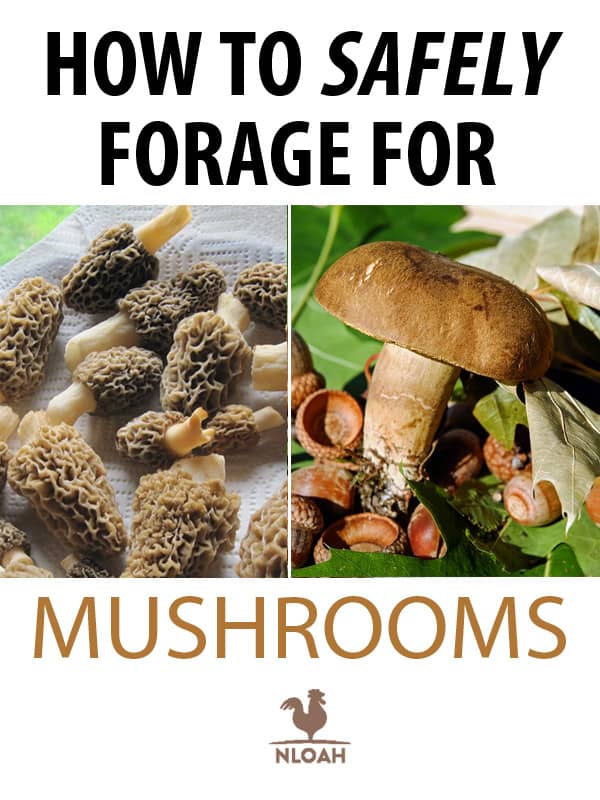

Allison Sayer lives in a schoolbus on an off-grid property in the Alaskan Copper Valley. She has been part of many amazing projects. These include cooking at a remote nature center, managing a multi-family hoop house, volunteering at a chicken sanctuary, and WWOOFing on a small farm. Through her deep friendships throughout the Alaskan wilderness, she has helped many friends develop their homes and dreams. Allison is currently building up her property with the goal of starting her own microgreen farm.

I really like mushrooms but I’ll stick to the store bought ones, it would be my luck to get hold of a deadly one.